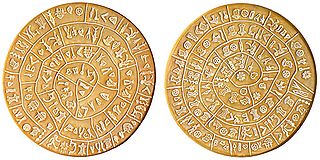
The Ligures or Ligurians were an ancient people after whom Liguria, a region of present-day north-western Italy, is named.

Blera is a small town and comune in the northern Lazio region of Italy. It was known during the Middle Ages as Bieda, an evolved form of its ancient name, which was restored in the twentieth century. It is the birthplace of Pope Sabinian; Pope Paschal II was also originally thought to be from here.

Artena is a town and comune in the Metropolitan City of Rome, Italy. It is situated in the northwest of Monti Lepini, in the upper valley of the Sacco River. It is approximately 40 kilometres (25 mi) southeast by rail, and 30 kilometres (19 mi) direct from Rome.
Giovanni Becatti was an Italian Classical art historian and archaeologist.
Mario Torelli was an Italian scholar of Italic archaeology and the culture of the Etruscans. He taught at the University of Perugia.
Clementina Panella is an Italian archaeologist, a professor at the University of Rome La Sapienza, where she teaches Methodology of Archaeology. She has guided and co-written a number of articles on the commercial pottery of ancient Italy.

Ostia Antica is the 35th zona of Rome, Italy, four kilometers away from the coast. It is identified by the initials Z. XXXV and it is distinct from Ostia. Ostia Antica belongs to Municipio X.

Luigi Pernier was an Italian archaeologist and academic now best known for his discovery of the Disc of Phaistos.

Nostra Segnora de Mesumundu is a religious building in the territory of Siligo, Sardinia, Italy.

The Giants of Mont'e Prama are ancient stone sculptures created by the Nuragic civilization of Sardinia, Italy. Fragmented into numerous pieces, they were discovered in March 1974 on farmland near Mont'e Prama, in the comune of Cabras, province of Oristano, in central-western Sardinia. The statues are carved in local sandstone and their height varies between 2 and 2.5 meters.

Vassallaggi is a Sicilian prehistoric Bronze Age archaeological site, located on the hill of the same name, which had a later flourishing after the 7th century BC as a phrourion (fortress). The site is located in the middle of the Salso river valley, at 704 m above sea level, near San Cataldo in the province of Caltanissetta, in a strategic location for communication between the southern coast of Sicily and the northern part of the island. It has a NE-SW orientation and stretches along in parallel with the SS 122 San Cataldo-Serradifalco.
Maria Bonghi Jovino is an Italian archaeologist. Bonghi Jovino was Professor of Etruscology and Italic Archaeology at the University of Milan.

Raissa Samojlovna Calza was a Ukrainian dancer who became a prominent classical archaeologist of Roman portraiture. When she was young, she fled to Italy and France following the Russian Revolution.

Maria Floriani Squarciapino (1917-2003) was an Italian classical archaeologist and professor at La Sapienza University in Rome, known for her work on the Roman port city of Ostia.
John Moulton Day was an American historian.

San Silvestro is a Roman Catholic pieve dedicated to Saint Sylvester located in the municipality of Larciano, in the province of Pistoia, in Tuscany, Italy. The property belongs to the Diocese of San Miniato, Florence.
Lucia Guerrini (1921–1990) was an Italian classical scholar, archaeologist and professor. After participating in the Phaistos excavations in Crete in 1957, she became an enthusiastic editor of the Enciclopedia dell'arte antica, classica e orientale under the auspices of Ranuccio Bianchi Bandinelli. From the 1950s, she taught Greek and Roman Art at the Sapienza University of Rome, succeeding Bandinelli as Professor of Archaeology and Greek and Roman Art in 1973. Guerrini participated in projects relating to Greek and Roman iconography, Coptic art and the Antinoöpolis excavations in Egypt.

The Mesumundu Archaeological Park is an archaeological complex located in Siligo, in the province of Sassari, in Sardinia. Extending for over one hectare, it is located in an alluvial plain bordered by a series of basaltic plateaus, near an ancient path which, already existing in the protohistoric age, was rearranged in the Roman age; it is crossed by the Riu Mannu of Porto Torres.

In architecture, bacini are ceramic bowls that were used for decoration in the medieval Europe. The bowls were embedded into the external walls of buildings and are thus also known as immured vessels. Bacini represent one of the traits of the Pisan Romanesque style. They can also be found in the Byzantine and Gothic buildings.












